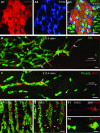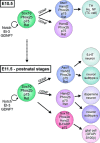Development of enteric neuron diversity
- PMID: 19538470
- PMCID: PMC4496134
- DOI: 10.1111/j.1582-4934.2009.00813.x
Development of enteric neuron diversity
Abstract
The mature enteric nervous system (ENS) is composed of many different neuron subtypes and enteric glia, which all arise from the neural crest. How this diversity is generated from neural crest-derived cells is a central question in neurogastroenterology, as defects in these processes are likely to underlie some paediatric motility disorders. Here we review the developmental appearance (the earliest age at which expression of specific markers can be localized) and birthdates (the age at which precursors exit the cell cycle) of different enteric neuron subtypes, and their projections to some targets. We then focus on what is known about the mechanisms underlying the generation of enteric neuron diversity and axon pathfinding. Finally, we review the development of the ENS in humans and the etiologies of a number of paediatric motility disorders.
Figures



Comment in
-
Interplay among enteric neurons, interstitial cells of Cajal, resident and not resident connective tissue cells.J Cell Mol Med. 2009 Jul;13(7):1191-2. doi: 10.1111/j.1582-4934.2009.00814.x. Epub 2009 Jun 16. J Cell Mol Med. 2009. PMID: 19538469 Free PMC article. No abstract available.
Similar articles
-
Neuron-Glia Interaction in the Developing and Adult Enteric Nervous System.Cells. 2020 Dec 31;10(1):47. doi: 10.3390/cells10010047. Cells. 2020. PMID: 33396231 Free PMC article. Review.
-
Pleiotropic effects of the bone morphogenetic proteins on development of the enteric nervous system.Dev Neurobiol. 2012 Jun;72(6):843-56. doi: 10.1002/dneu.22002. Dev Neurobiol. 2012. PMID: 22213745 Free PMC article. Review.
-
Bone morphogenetic protein regulation of enteric neuronal phenotypic diversity: relationship to timing of cell cycle exit.J Comp Neurol. 2008 Aug 10;509(5):474-92. doi: 10.1002/cne.21770. J Comp Neurol. 2008. PMID: 18537141 Free PMC article.
-
The enteric neural crest progressively loses capacity to form enteric nervous system.Dev Biol. 2019 Feb 1;446(1):34-42. doi: 10.1016/j.ydbio.2018.11.017. Epub 2018 Dec 7. Dev Biol. 2019. PMID: 30529057
-
Neuronal Differentiation in Schwann Cell Lineage Underlies Postnatal Neurogenesis in the Enteric Nervous System.J Neurosci. 2015 Jul 8;35(27):9879-88. doi: 10.1523/JNEUROSCI.1239-15.2015. J Neurosci. 2015. PMID: 26156989 Free PMC article.
Cited by
-
Bioengineering the gut: future prospects of regenerative medicine.Nat Rev Gastroenterol Hepatol. 2016 Sep;13(9):543-56. doi: 10.1038/nrgastro.2016.124. Epub 2016 Aug 10. Nat Rev Gastroenterol Hepatol. 2016. PMID: 27507104 Review.
-
Who's talking to whom: microbiome-enteric nervous system interactions in early life.Am J Physiol Gastrointest Liver Physiol. 2023 Mar 1;324(3):G196-G206. doi: 10.1152/ajpgi.00166.2022. Epub 2023 Jan 10. Am J Physiol Gastrointest Liver Physiol. 2023. PMID: 36625480 Free PMC article. Review.
-
Essential roles of enteric neuronal serotonin in gastrointestinal motility and the development/survival of enteric dopaminergic neurons.J Neurosci. 2011 Jun 15;31(24):8998-9009. doi: 10.1523/JNEUROSCI.6684-10.2011. J Neurosci. 2011. PMID: 21677183 Free PMC article.
-
Transcription and Signaling Regulators in Developing Neuronal Subtypes of Mouse and Human Enteric Nervous System.Gastroenterology. 2018 Feb;154(3):624-636. doi: 10.1053/j.gastro.2017.10.005. Epub 2017 Oct 12. Gastroenterology. 2018. PMID: 29031500 Free PMC article.
-
Glial cells in the mouse enteric nervous system can undergo neurogenesis in response to injury.J Clin Invest. 2011 Sep;121(9):3412-24. doi: 10.1172/JCI58200. Epub 2011 Aug 25. J Clin Invest. 2011. PMID: 21865647 Free PMC article.
References
-
- Furness JB. The enteric nervous system. Oxford, UK: Blackwell; 2006.
-
- Hoff S, Zeller F, Von Weyhern CW, et al. Quantitative assessment of glial cells in the human and guinea pig enteric nervous system with an anti-Sox8/9/10 antibody. J Comp Neurol. 2008;509:356–71. - PubMed
-
- Gershon MD. The second brain. New York: Harper Collins; 1998.
-
- Timmermans JP, Hens J, Adriaensen D. Outer submucous plexus: an intrinsic nerve network involved in both secretory and motility processes in the intestine of large mammals and humans. Anat Rec. 2001;262:71–8. - PubMed
-
- Costa M, Brookes SJ, Steele PA, et al. Neurochemical classification of myenteric neurons in the guinea-pig ileum. Neuroscience. 1996;75:949–67. - PubMed
Publication types
MeSH terms
LinkOut - more resources
Full Text Sources
Other Literature Sources

